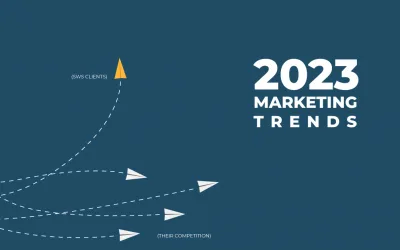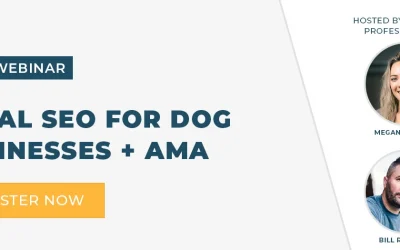Part of an effective digital marketing strategy involves search engine optimization, or optimizing your website for services you want to be found for. There are many steps that go into optimizing your site or webpages for search, and understanding how to use them to your advantage can go a long way in boosting your brand awareness, site traffic, and conversions.
A Step-by-Step Guide to Optimizing for SEO
We, at this point, understand that optimizing your site for search means creating new content or manipulating existing content in such a way that allows your website to show up on the search engine results page (SERP).
But how do you do it?
Here we outline the steps we take to identify a topic and optimize around that topic.
Identifying Your Topic and Actionable Key Phrases
The most essential part of an effective SEO strategy is having a list of service-based, actionable key phrases that bring up your competition in the SERP. An “actionable” key phrase has high search volume and the SERP displays associated business (competition).
You can tell if your selected key phrase is actionable if after you search for it in the search engine, it:
- Shows your competition & other companies in the area: This tells us it is worth our time to optimize. Google is showing our local competition.
- Displays pay-per-click (PPC) ads: This tells us it is a valuable enough keyphrase that Google is displaying paid search ads
- Shows a Google Map Pack result with related companies: This tells us that the search is location based and Google deems it necessary to show local search results.
For instance, an HVAC provider might select “air conditioner repair” as their head key phrase because it is actionable (shows a lot of people bidding on it, competitors, a map pack, and other HVAC companies, etc.) and has a high search volume of 90,000 per month. While a phrase like “my ac won’t turn on” is not very actionable. This SERP doesn’t show any competitors, is low search volume, and the links on that page are informational in nature. This isn’t to say that a phrase like this won’t play a part in our overall SEO strategy, it is just not a phrase we should have as a primary focus for our AC Repair Page.
Optimizing Around Your Head Key Phrases
Once you have selected your topic and associated actionable head key phrases, you’ll need to identify the page on your website for which you’d like the phrase to rank.
If you don’t have an existing page on your site for this service, you’ll need to create one. You’ll need to ensure the page we are optimizing or creating makes sense for this phrase. To use our example and we want to rank for the term “air conditioner repair,” it wouldn’t make sense to optimize your about page around this phrase. Each page of your site should have a clear target that matches a user’s search intent.
You will also want to make sure this page fits your site’s hierarchy. A page like air conditioner repair should be nested under a parent AC services section of your website. So for example, our URL should look something like this: https://domain.com/hvac-services/air-conditioner-repair/
Bonus Tip: make sure your URL contains the keyword you are optimizing for.
Identifying Keyword Variances
In addition to selecting head key phrases, you’ll also need to identify keyword variances. These are keywords and phrases that are similar to the head key phrase. Using these variants are helpful for optimization purposes as they help Google understand what your page is about. This, in turn, helps your website rank higher.
So, in addition to “air conditioning repair,” an HVAC specialist may want to include variant phrases like “AC repair” or “AC repair near me” to increase their chances of reaching the right people at the right time.
Creating a Content Outline
Now that you know what targets we are after and what page of the site needs the content, we will need to now build a content outline. To create a content outline, you’ll need to identify all of the things that your target consumer needs to know about your this offering.
Let’s return to our air conditioning repair example: Your content outline in this case might include sections like “Common Signs Your AC is Broken,” “Why Choose [Your Company] for AC Repair?” or the “AC Repair Process.”
It’s important to have an easy-to-follow structure in your content outline as it will ensure that both Google and your viewers understand what the page is about. One way you can do this is by entering your head key phrase and taking a look at how some of the highest-ranked pages are structured. The goal is not to copy them, but to use them as inspiration for how you can emulate their SEO success.
Writing the Content
Writing your website content can be a challenge, especially if you’re unfamiliar with how to write for SEO. Not only do you need to think about what info belongs on the page and within specific sections of your content outline, but you need to follow SEO writing best practices.
If you’re like most business owners, you don’t have time to write the content yourself.
Thankfully, there are plenty of writing services and freelance writers available through companies like Upwork, Textbroker, and Fiver that can help produce the content you need.
Building the Pages
As aforementioned, SEO writing best practices are a must for producing effective content. This is especially important when building the webpage: The person building your site content must use appropriate headline structure, implement bolded lists when appropriate, and utilize images that are properly optimized with alt tags and labels.
An ideal page/headline structure would be something like:
H1 – Air Conditioner Repair in City, State
- Including the location can help optimize to local searches.
- Make sure your parent H1 headline is making strong use of the parent keyword.
H2 – Common Symptoms that require AC Repair
- With the remaining H2 headlines we reinforce the parent topic
- Each section should then break down the content we are introducing
H2 – Why Choose us for your AC repair needs
H2 – The AC Repair Process
Additionally, you’ll need to ensure each page contains keyword-rich title tags and a convincing meta-description that compels searchers to make the click to your page.
A perfect title tag should be in Google’s best practices (Between 55-70 characters), keyword rich, and specific. For Example:
Air Conditioner Repair | AC Repair Services in City, State
A great meta description should contain a compelling reason to click and also fall with Google’s best practices (between 920-990 characters), For Example:
When your air conditioner is in need for repair, choose Business Name. We arrive on-time, fix things right the first time, and offer a money back guarantee.
Adding Available Schema Markup
Schema markup is a type of microdata that, when added to your page, creates a rich snippet that appears in search results, making your website appear more prominently in SERPs. These rich snippets can be added for a number of reasons, including:
- Highlighting local businesses
- Answering frequently asked questions
- Providing events information
- Showcasing testimonials
There are tons of opportunities for optimization with schema, so be sure to think about how you can take advantage when building out your site content.
Getting Links to Your Page
Once your page is created, you’ll need to ensure its easily accessible by linking to it from other pages on your site. If it’s a top-tier page, the first link you want to implement should be from the header, footer, or navigation menu. Additionally, you’ll want to get a powerful link from the homepage in editorial content (a link within text).
Don’t be too generous with the number of times you link from the same page: Google only references the first editorial link to a page. That means if you have one link at the top and one at the bottom, only the anchor text from the top link is registered.
Linking from Relevant Pages
In addition to linking from headers, footers, and navigation menus, you’ll want to spend time identifying other existing pages from which you can link to your newly optimized content. For example, if you have a parent page for HVAC services, it makes sense to insert a link to the “air conditioning repair” page.
Choosing Keyword-Rich Anchor Text
Anchor text is the actual text on the page that links you to another page. This is a critical component of your site’s content as this is what Google uses to determine how pages link to one another. Let’s use the following sentence as an example:
Contact us to schedule air conditioning repair in your home!
Rather than using the generic anchor text “contact us,” you can strengthen Google’s contextual understanding of your page by using the anchor text “schedule air conditioning repair.”
Creating Supporting Page Content
It’s not enough to have one page of content around a given topic. You need enough supporting content on your site that signals to Google that your company is a good source of information on the subject. Supporting content could be a blog post that talks about HVAC repair, or an FAQ page that talks about “air conditioning repair” specifically. To create the best supporting content for your page, try the following:
- Keyword Research: Identify long-tail keywords for which your target audience is searching. Long-tail keywords are more specific in nature and usually have lower competition, giving you an increased likelihood of appearing before the right person at the right time.
- People Also Ask: Enter your search term into Google and check out the “people also ask” section of the results page. Using these questions, you can create content around the most commonly searched for topics related to your products and services.
- Answer the Public: Like Google’s “people also ask” section, Answer the Public is a unique tool that shows what questions people ask the most related to a given topic. Creating supporting content that answers customers’ questions is an extremely effective SEO tactic.
Linking Back to Supporting Content
Once your supporting content has been created, you’ll need to find strategic ways to link back to the initial new page. Always create between three and five content pieces as secondary content that can link back to the new page.
Focusing on External Activity
The next step to strengthening your site’s SEO is generating links back to your website from external sources. One way you can do this is by using a back-link checker tool to identify places that are more likely to link to your site. Simply grab a competitor site’s URL and plug it into your chosen back-link checker (we recommend Majestic or AHREFS) to see what entities you can reach out to that will provide a valuable back-link to your page.
Keeping Up with Maintenance
After a site is built and optimized, your work isn’t done. It requires ongoing maintenance to ensure the site is working properly and to search for new content opportunities on which you can capitalize. Ongoing activities include using Google Search Console to identify content opportunities, using AHREFS to identify back-link opportunities, checking Google Analytics for site statistics, and internal content creation.
SEO Strategy is a Long Term Strategy
A complete SEO strategy is the only way to gain position and outperform your competition in search. By creating content specific to user queries, adhering to SEO structural best practices, and keeping up with ongoing maintenance, you can dramatically improve your brand awareness, site traffic, and conversions.
While certainly a labor-intensive endeavor, the results you achieve from optimizing your site for SEO will be well worth the hours of work you put into your strategy.




